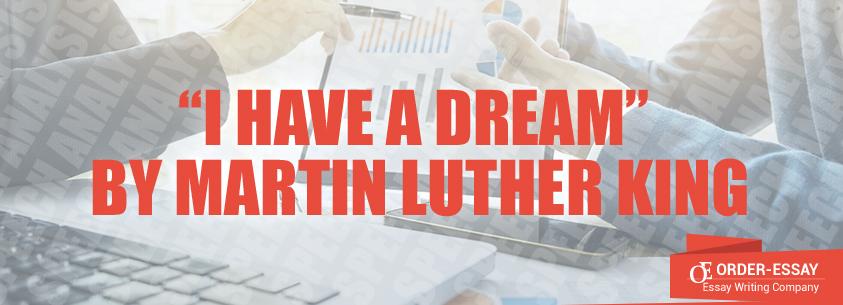
Most of all speeches are delivered with the aim to make a certain influence on the listener. For this reason, persuasive speeches, despite having different subjects and patterns of organization, have some characteristics that indicate that the speech is written to convince. Martin Luther King’s speech “I Have a Dream” on a necessity of equality of all people and emancipation of African Americans, which was promised by the Declaration of Independence and Emancipation Proclamation decree, is a perfect example of a persuasive speech with careful use of Aristotle’s concepts of ethos, pathos and logos and different patterns and stylistic devices that make the speaking more convincing.
Martin Luther King adheres to different rhetorical strategies to make an appeal to the audience, to convince it to approve his view. First, it is necessary to admit he uses logos to provide a support for the ideas he expresses. There are examples of deductive reasoning in the speech. Talking about the promises and liberties guaranteed to all people, Martin Luther King concludes that African Americans must be free as well as white people who live in the United States of America (King, 1963). Apparently, he forms a judgment on generalization about all people and narrows it to black people who live in the U.S. It is possible to find examples of inductive reasoning as well. The narrator speaks about unfair treatment of black people and then claims that this fact is a sign of the fall of justice in the USA in general (King, 1963), which will, without doubt, influence all people.
Ethos is also effectively used in the speech. Being an ethical appeal on the author, ethos makes the audience trust the narrator, approve his position or her and follow the suggestions the author makes. Martin Luther King refers to sources that are trustworthy and reliable. For instance, he mentions the statements proclaimed in the Declaration of Independence and Lincoln’s Emancipation Proclamation (King, 1963). The narrator also quotes King James Version of Holy Bible, which is respected by almost all listeners: “and the glory of the Lord shall be revealed and all flesh shall see it together” (King, 1963). One point about ethos that is not followed by Martin Luther King is stating the opposing position. He does not provide the information that slavery might bring some benefits to the country as he is totally against it. However, this ignorance of mentioning the fact of such kind is even more effective as in this case, the narrator appeals to the sensibilities and emotions of the audience. It is possible to say, he uses pathos instead of ethos in some parts of his speech.
Another example of ethos is establishing common ground with the audience. Martin Luther King is black, he speaks about black, many of the audience were black. It was an additional “bonus” for the speaker. He sets himself equal to all people who listen to him as he shares widely supported opinions about emancipation of black people, he respects and adheres to the Bible (that is a sign of establishing common ground as almost all people at that time in the USA were Christians), and he talks about the ideas expressed in the government documents that should be abided and respected by all people who live in the United States of America. With the help of emotionally strong words, the narrator expresses his personal interest in the subject. He also uses singular and plural first person pronouns “I” and “We” to show that he is an active participant in the case and that he is concerned with the issue. Martin Luther King does not use excessively long sentences, structures that are hard to follow, and for this reason, his speech is comprehended in a better way and, therefore, it makes greater influence on the audience.
Pathos, as emotional appeal, is used the most effectively and the pathos strategies make Martin Luther King’s speech very persuasive. For instance, the narrator uses different grammar structures that are emotionally loaded: “Now is the time” (King, 1963). He also uses imperative sentences to make the readers approve his suggestions, support his view, for instance, he says “Continue to work with the faith that unearned suffering is redemptive” and “Go back to Mississippi, go back to Alabama, go back to South Carolina, go back to Georgia, go back to Louisiana, go back to the slums and ghettos of our northern cities, knowing that somehow this situation can and will be changed” (King, 1963). These sentences make people have the same attitude to the problem and call them for action. Martin Luther King uses such synonymic adjectives to describe the problem and to make the audience care about it: “withering”, “languished”, “sweltering” and others (King, 1963). Consequently, the speaker appeals to emotions of the listeners.
There are different examples of stylistic devices that make the text persuasive in Martin Luther King’s speech. The narrator often uses repetitions to make the audience pay attention to the main points and to convince it: “Now is the time”, “I have a dream”, “Let freedom ring”, “One hundred years later”, “We refuse to believe”, “We can never be satisfied”, “With this faith” and others (King, 1963). One can find an example of analogy: King compares civil rights of people to a check, with an emphasis of the neglecting black people rights and economic concern of the government. The narrator also uses simile to compare two things and makes the audience feel the difference and similarity: “No, no, we are not satisfied, and we will not be satisfied until “justice rolls down like waters, and righteousness like a mighty stream”” (King, 1963). Here is an allusion to the Bible. The example of metaphor is “With this faith, we will be able to hew out of the mountain of despair a stone of hope” (King, 1963). There are some other devices used in the speech to make it more emphatic. With the help of them, the narrator makes his speech inspirational, makes the audience pay attention to the issue and calls it for action.
All in all, Martin Luther King’s speech “I Have a Dream” is very persuasive. The narrator effectively uses persuasive rhetorical strategies, such as ethos, pathos and logos (deductive and inductive reasoning) that make the author trustworthy and convince the audience to believe in the truthfulness of the opinions expressed by the narrator. The speaker also uses emphatic structures, emotionally loaded words and different stylistic devices to make the audience more concerned and convince it to fight for the rights of black people in the United States. Therefore, Martin Luther King appeals to various persuasive arguments in order to be heard and supported.











